SIEM REAP, CAMBODIA - “Have you heard about the lost city?” asks Sean, our Cambodian guide, who seems eager to expand our horizons beyond the temple complex of Angkor Wat.
Lost city? We’re intrigued.
So the next day, in the golden light of morning, the three of us head for the hills, better known as Phnom Kulen (“mountain of lychees”). We’re searching for remnants of the buried city of Mahendraparvata (“Mountain of Great Indra”), some 50 km away.
Although Sean had his life upended by the Pol Pot regime — he candidly tells us he didn’t begin school until age 13 — today he is fluent in English and deeply knowledgeable about the treasures in these mythic hills.
He tells me that three years ago, Australian archeologist Damian Evans rocked the scientific world by proving that a vast, well-designed city lies hidden beneath the jungle on Cambodia’s most sacred mountain. Using Lidar technology (laser cameras mounted on planes), Evans discovered patterns of complex cities dating from 802 AD, more than three centuries before the earliest temples were built at Angkor. Cambodia was then a Hindu realm, ruled by the god-king King Jayavarman II. Later the kingdom moved to Angkor, probably due to deforestation and lack of water.
After more than 1500 years, 30-odd temples buried beneath the jungle floor were uncovered. One of the remnants of that period is the “Elephant Pond”, a 9th century grouping of giant statues that includes elephants, lions and frogs.
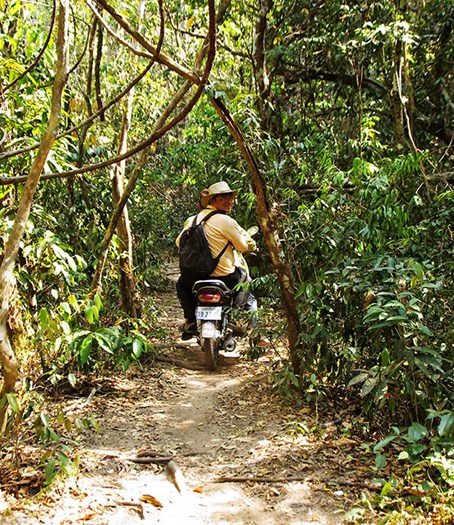
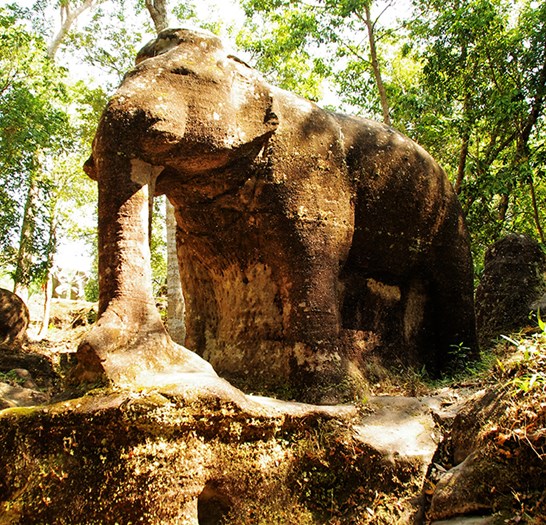
Left: Heading off into the Cambodian jungle. Right: Coming upon the remains of the elephant temple.
Ninety minutes after leaving Siem Reap, we pull up at a nondescript village: a few eateries, a sundry shop or two. There are few foreigners. Turning around, I’m greeted by three smiling Cambodian men — our drivers, it appears.
Pardon me? Did someone mention motorbikes, I ask?
Everyone is so eager, so friendly that I willingly accept our mode of jungle transportation and climb aboard — digging my fingers into the driver’s waist. We pass small villages where a Buddhist monk gets respect from the locals — heads bow as he passes through town — and fly pass tropical jungle filled with banyan trees whose roots wrap around the massive timber like snakes. The tiny scooter slips and slides through sand and shallow pools but Teng, my driver, knows these trails well and soon I feel secure in his charge.
Entering a tree-shaded glade, we slow, then stop. This is Srai Damrei (Elephant Pond), he informs me.
Under dappled sunlight, massive stone beasts from long ago stand guarding their turf. They were carved sometime in the 9th century in then Hindu Cambodia — Buddhism arrived here late in the 12th century.
We are the only visitors, but others have come before us, leaving sticks of incense and offerings of fruit at the carvings’ base. Instinctively, we kneel, lighting sticks of incense handed to us by Sean, “for good luck.”
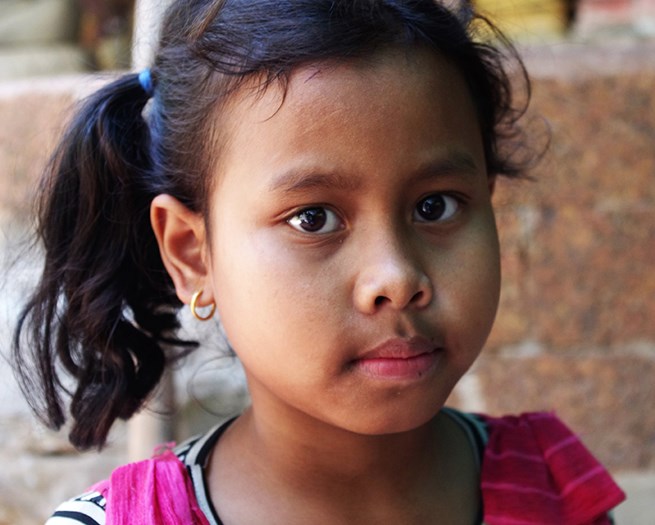
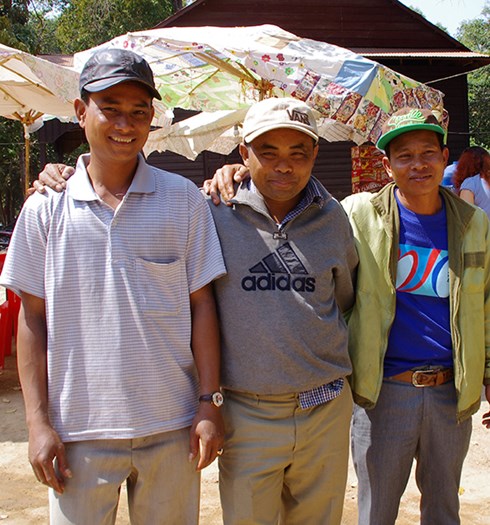
Left: Some of the lovely village children. Right: The motorcycle riders are a fearless lot.
A woodpecker knocks, a bald eagle passes overhead. Otherwise, silence.
After lingering in this “Holy Place for Worship,” Sean suggests a side trip to caves that he guarantees will be cooler than the sweltering jungle.
A 10 minute ride deposits us at the mouth of some cool, dark caves, replete with Buddha images, flowers and candles. Did someone mention bats? The caves are filled with them.
Seasoned passengers by now, we hop aboard the bikes again and celebrate our arrival back in the village with a feast: catfish, grilled chicken, rice, sour fruit wrapped in banana-leaf, pickles — $10 for the six of us!
Sean smiles, explaining that when he was starving under the Khmer Rouge, he said to himself, “If I ever have money, I’ll eat like a king.”
After lunch we enter Phnom Kulen National Park, home to the temple of Wat Preas Ang Thom, famed for its 16th century Reclining Buddha, carved out of mountain sandstone.
After removing our shoes, we climb the temple steps, drawn forward by chanting sounds.
In the temple we come upon a pair of saffron-clad monks — one is heavily tattooed. Next we discover the eight-metre-high Buddha, lying peacefully on its side. More devotees gather here, lighting incense, leaving fruit, praying and basking in the great Buddha’s presence.
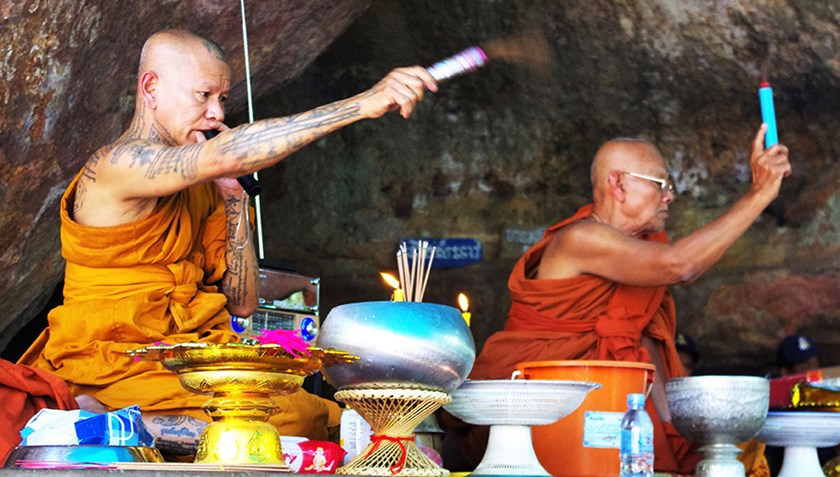
Above: The local monks hold their ancient ceremonies in the deep, dark caves of the area.
Pure fun awaits nearby, at the park’s waterfalls. It’s the dry season, so the falls aren’t terribly high, but families happily gather for picnics, swimming, frolicking. Ladies sell dishes brought from home.
These are local folk, not foreigners, all out for a day’s enjoyment, seemingly carefree — with little thought of lost cities or vanished empires.
Information
The easiest way to get to Cambodia from Canada is with either Air Canada or Cathay Pacific Airlines via Hong Kong. / Nancy Wigston was put in touch with her guide Sean by the cruise director of her Avalon Mekong River Cruise. Other tour options are available, including hikes up the mountain, but guides are necessary for any excursion to Mount Kulen. / Although this area of Cambodia has long been cleared of land mines, travelling alone in the jungle is not recommended. / Tour East Holidays offers a number of value-added tours of Cambodia, which also include tours of Vetnam and Laos. For more details, go to
http://www.toureast.com
About the Author
Longtime travel writer and book critic Nancy Wigston has been entranced by travel her whole life, from her first backpacking trips in Europe to living in England and SE Asia. Whenever possible, she visits old friends and discovers new destinations all over this beautiful planet, usually with a book or two in hand. She has freelanced for major publications in the U.K., Asia, and Canada and is the proud recipient of many travel writing awards.